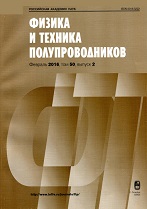|
This article is cited in 2 scientific papers (total in 2 papers)
Semiconductor physics
Modification of the $n$-surface profile of AlGaInN LEDs by changing the gas-mixture composition during reactive ion etching
L. K. Markov, I. P. Smirnova, M. V. Kukushkin, A. S. Pavluchenko
Ioffe Institute, St. Petersburg
Abstract:
The kind of profile produced during the reactive ion etching of AlGaInN light-emitting-diode (LED) heterostructures on the surface that became free after removal of the growth substrate is studied in relation to the composition of the gas mixture used in the etching process. It is shown that using a mixture composed of Cl$_2$ and Ar, taken in a 3:2 ratio in terms of flow rates, leads to the thinnest profile, whereas a 2:1 gas mixture of BCl$_3$ and Ar provides the largest structural elements. To study the effect of the kind of profile on the quantum efficiency (QE), flip-chip LEDs are fabricated on a silicon substrate. The LEDs are etched in different modes after the growth substrate is removed. Etching in the Cl$_2$:BCl$_3$:Ar mixture with a flow ratio of 6:10:11, which leads to intermediate sizes of the etching profile elements, is optimal for obtaining maximum light extraction from a LED chip at a wavelength of 460 nm. The variation of the kind of profile with the gas-mixture composition suggests that the profile parameters can be tuned to the wavelength used. An analysis of how the QE of LED chips depends on the etching duration in the three-component mixture under consideration results in that the optimum etching duration is estimated to be $\sim$30 min. The results of the study can also be of use in the search for conditions minimizing the reflection of incident light by a chip, e.g., for photodetectors.
Keywords:
light-emitting diode, light-emitting chip, surface profile, reactive ion etching, flip-chip design, gallium nitride.
Received: 22.01.2020
Revised: 28.01.2020
Accepted: 28.01.2020
Citation:
L. K. Markov, I. P. Smirnova, M. V. Kukushkin, A. S. Pavluchenko, “Modification of the $n$-surface profile of AlGaInN LEDs by changing the gas-mixture composition during reactive ion etching”, Fizika i Tekhnika Poluprovodnikov, 54:6 (2020), 564–569; Semiconductors, 54:6 (2020), 672–676
Linking options:
https://www.mathnet.ru/eng/phts5222 https://www.mathnet.ru/eng/phts/v54/i6/p564
|


| Statistics & downloads: |
| Abstract page: | 39 | | Full-text PDF : | 15 |
|





 Contact us:
Contact us: Terms of Use
Terms of Use
 Registration to the website
Registration to the website Logotypes
Logotypes








 Citation in format
Citation in format 
